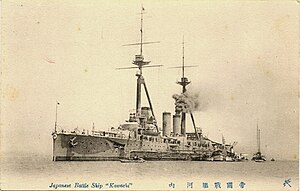Kawachi class battleship

A postcard of Kawachi
|
|
| Class overview | |
|---|---|
| Name: | Kawachi class |
| Builders: | |
| Operators: |
|
| Preceded by: | Satsuma class |
| Succeeded by: | Fusō class |
| Built: | 1909–1912 |
| In service: | 1912–1945 |
| In commission: | 1912–1923 |
| Completed: | 2 |
| Lost: | 1 |
| Scrapped: | 1 |
| General characteristics | |
| Type: | Dreadnought battleship |
| Displacement: | 20,823–21,443 long tons (21,157–21,787 t) (normal) |
| Length: | 526–533 ft (160.3–162.5 m) |
| Beam: | 84 ft 3 in (25.7 m) |
| Draft: | 27–27.8 ft (8.2–8.5 m) |
| Installed power: |
|
| Propulsion: | 2 shafts, 2 steam turbine sets |
| Speed: | 21 knots (39 km/h; 24 mph) |
| Range: | 2,700 nmi (5,000 km; 3,110 mi) at 18 knots (33 km/h; 21 mph) |
| Complement: | 999–1100 |
| Armament: |
|
| Armor: |
|
The Kawachi class (河内型戦艦 Kawachi-gata senkan?) was a two-ship class of dreadnought battleships built for the Imperial Japanese Navy (IJN) in the first decade of the 20th century. Both ships bombarded German fortifications at Tsingtao during the Battle of Tsingtao in 1914, but saw no other combat in World War I. Kawachi sank in 1918 after an explosion in her ammunition magazine with the loss of over 600 officers and crewmen. Settsu was disarmed in 1922 and converted into a target ship two years later to meet the terms of the Washington Naval Treaty and served until she was sunk in 1945 by American carrier aircraft. The ship was refloated after the war and scrapped in 1946–47.
The Kawachi class was ordered on 22 June 1907 under the 1907 Warship Supplement Program after the Russo-Japanese War as Japan's first dreadnoughts, although their construction was delayed by a severe depression. They were one of the first steps in the fulfillment of the recently adopted Eight-Eight Fleet Program that required a fleet of eight dreadnoughts and armored cruisers. Their design was based on the Aki with a uniform 12-inch (305 mm) main-gun armament in the hexagonal layout used by the German dreadnoughts of the Nassau and Helgoland classes.
...
Wikipedia
